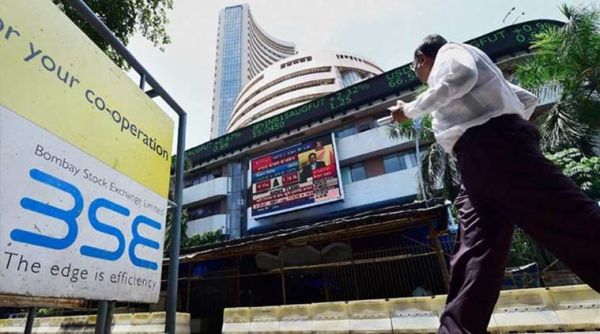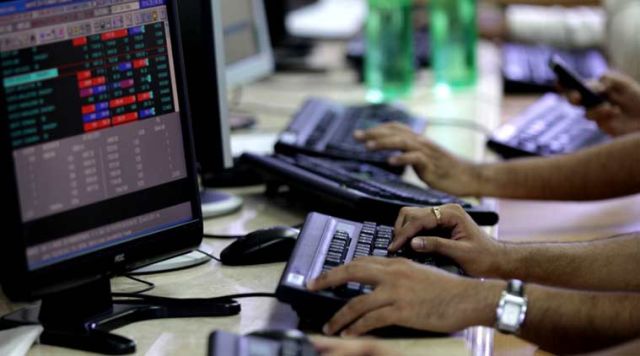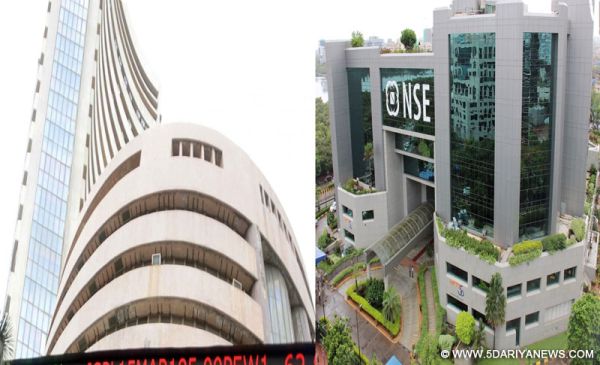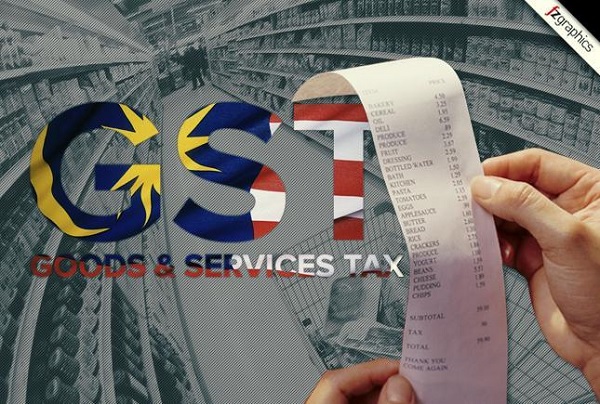
by admin | May 25, 2021 | Economy, Markets, News
 By Rohit Vaid,
By Rohit Vaid,
Mumbai : Fears over the imposition of more trade protectionist measures, along with a parliamentary deadlock may flare up further volatility in the domestic equity market in the coming truncated trade week.
Besides, triggers such as higher crude oil prices, derivatives expiry and the upcoming macro-economic data points are expected to influence investors’ sentiments.
“Markets next week would continue to be volatile guided by global developments on the ongoing trade issues between the US and China as well as the local political developments, especially the outcome of Rajya Sabha polls,” Devendra Nevgi, Founder and Principal Partner, Delta Global Partners, told IANS.
“Oil prices (Brent) have hit $70, adding to the risk aversion in India.”
Last week, economic tensions between the world’s two largest economies escalated after the US imposed tariffs on Chinese products and China announced plans for a retaliatory action.
“Market is expected to continue its volatile trade going forward and investors will continue to keep close eye on further actions by Donald Trump and the reaction of the Chinese government,” said D.K. Aggarwal, Chairman and Managing Director of SMC Investments & Advisors.
“Besides, global macroeconomic data releases, the movement of rupee against the dollar, crude oil price movement, investment by FPIs (foreign portfolio investors) and DIIs (domestic institutional investors) will continue to give direction to the markets.”
In addition, parliamentary proceedings, macro-economic points like Index of Eight Core Industries (ECI) figures, along with the country’s fiscal deficit numbers up to February and its external debt data will be keenly watched by investors.
“The fiscal deficit number for February to be declared on the coming Wednesday (March 28) will be closely watched for slippages,” Nevgi said.
According to Vinod Nair Head of Research at Geojit Financial Services, apart from weak global cues, domestic market “is underperforming” due to premium valuation, profit booking led by LTCG (long-term capital gains) tax and pre-election political uncertainties.
“We can expect this domestic chaos to stabilise by the end of FY18, as redemption pressure will be over. But due to risk of escalation in global trade war and domestic pre-election uncertainties, volatility may continue for some more time,” Nair said.
“The week ahead is truncated with two market holidays and F&O expiry adding volatility.”
Investment-wise, provisional figures from the stock exchanges showed that last week, foreign institutional investors purchased scrip worth Rs 2,524.13 crore and the DIIs invested Rs 211.91 crore in equities.
The National Securities Depository (NSDL) revealed that FPIs invested Rs 2,060.04 crore, or $316.99 million in equities during March 19-23.
On the currency front, the rupee weakened by eight paise to close at 65.01 against the US dollar from its previous week’s close at 64.93.
Technical charts showed a bearish outlook for the National Stock Exchange’s (NSE) Nifty.
“The Nifty remains in downtrend and further downsides are likely early next week once the immediate supports of 9,952 points are broken,” said Deepak Jasani, Head of Retail Research for HDFC Securities.
“Immediate resistance is now at 10,227 points.”
The key Indian equity indices — the BSE Sensex and the NSE Nifty50 — closed last week at 5-month low levels on the back of trade protectionist measures, apart from the ongoing turmoil in the domestic banking system as well as the uncertainty on the political situation in the country.
Consequently, the 30-scrip Sensitive Index (Sensex) of the BSE shed 579.46 points or 1.75 per cent to 32,596.54 points — its lowest closing level since October 23, 2017.
Similarly, the Nifty50 of the NSE edged lower. It ended below the psychologically important 10,000-mark level and closed last week’s trade at 9,998.05 points — down 197.1 points or 1.93 per cent — its lowest closing level since October 11, 2017.
The Indian equity markets will be closed on Thursday and Friday on account of Mahavir Jayanti (March 29) and Good Friday (March 30), respectively.
(Rohit Vaid can be contacted at rohit.v@ians.in)
—IANS

by admin | May 25, 2021 | Economy, News
 Bhubaneswar : Odisha’s economy is estimated to grow at 7.14 per cent as against the national average of 6.5 per cent in 2017-18, a report said on Thursday.
Bhubaneswar : Odisha’s economy is estimated to grow at 7.14 per cent as against the national average of 6.5 per cent in 2017-18, a report said on Thursday.
According to the Economic Survey Report 2017-18, tabled in the state assembly, Odisha’s Gross State Domestic Product (GSDP) is estimated to grow at a rate of 7.14 per cent at 2011-12 prices, which surpasses all India growth rate of 6.5 per cent.
In terms of the size, GSDP at 2011-12 prices stood at Rs 2.30 lakh crore in 2011-12 and increased to Rs 3.23 lakh thousand crore in 2016-17.
It is further expected to rise up to Rs 3.46 lakh crore in 2017-18, showing a growth rate of 7.14 per cent compared to 2016-17, the report said.
The per capita income at base year price of the state in terms of GSDP is estimated to be Rs 77,193 in 2017-18, which experienced a 6.06 per cent rise from Rs 72,780 in 2016-17.
At current prices, the per capita income of the state during 2017-18 is likely to touch the level of Rs 92,727, while it will be Rs 126,349 at the national level.
The report said that service sector as a leading contributor to GSDP has contributed 38.54 per cent in 2011-12 which increases tremendously to 45.22 per cent in 2017-18 and surpasses agriculture and industry sector over years.
The sector exhibited an accelerated growth rate of 10.7 per cent in 2016-17 and is estimated to grow at 12.4 per cent in 2017-18, it added.
The consumer price inflation in the state exhibited a fluctuating trend and was the lowest level of 1.3 per cent in 2017 (up to November 2017) as against all India level of 3.1 per cent.
The share of agriculture has declined to 20 per cent from an overbearing 60 per cent in the 1960s, but the share of population dependent on the sector continues to be significant at around 50 per cent.
The report said there was a need for continued policy priority for agriculture, especially in its allied sectors, in view of the high employment potential and favourable agro-climatic conditions.
The mining, manufacturing and construction sectors were estimated to grow moderately at 4.6 per cent, while electricity, water supply and other utility services sub-sector is expected to clock a growth rate of 9.6 per cent, the report added.
—IANS

by admin | May 25, 2021 | Economy, Markets, News
 By Rohit Vaid,
By Rohit Vaid,
Mumbai : Volatility may persist in the key Indian equity indices, as global cues — prospects of trade wars, rise in US interest rates — and fears of domestic political instability are expected to dent investors’ risk-taking appetite, market observers opined.
“Markets would continue to face headwinds from the evolving political scenario domestically and the prospects of a trade war globally,” Devendra Nevgi, Founder and Principal Partner, Delta Global Partners, told IANS.
“Mixed macros data (points), fiscal year-end issues, higher IPO supply will keep the markets capped and range-bound, with lower bias.”
According to Vinod Nair, Head of Research at Geojit Financial Services: “The long-term outlook for the domestic market continues to be strong. However, rising concerns of global trade headwinds, domestic NPA issues and upcoming state elections will keep the market in tenterhooks.”
“Currently, the market is finding it difficult to stay float at support levels as volatility in global market brought the benchmark indices towards the 200 DMA. US Fed policy meet next week is the key event and the market expects a 0.25 basis points hike.”
Besides US Fed’s meet from March 20-21, investors are expected to keep a close watch on the direction of foreign fund flows and the rupee’s movement against the US dollar.
“Last week, news of the BJP’s defeat in by-polls increased the political risk premium on the rupee. We are in a pre-election year, where every regional electoral event will be seen through the lens of 2019,” Anindya Banerjee, Deputy Vice President for Currency and Interest Rates with Kotak Securities, told IANS.
“Over the next week, the most important economic event remains the US Fed’s decision on monetary policy. We expect a 25 basis points hike and a hawkish tone, which can be positive for the US dollar. As a result, USD-INR may witness a rally towards 65.30 levels on spot. We expect a broad range of 64.80 and 65.30 levels on spot.”
Last week, the rupee strengthened by 24 paise to close at 64.93 against the US dollar from its previous week’s close at 65.17.
On the investment front, provisional figures from the stock exchanges showed that foreign institutional investors (FIIs) purchased scrips worth Rs 6,288.23 crore and the domestic institutional investors (DIIs) worth Rs 202.69 crore during the week.
Figures from the National Securities Depository (NSDL) revealed that foreign portfolio investors (FPIs) invested Rs 6,713.73 crore, or $324.81 million, during March 12-16.
On technical levels, the National Stock Exchange’s (NSE) Nifty50 remains in downtrend.
“Technically, the Nifty remains in downtrend and further downsides are likely early next week once the immediate supports of 10,141 points are broken,” said Deepak Jasani, Head of Retail Research for HDFC Securities.
“Immediate resistance is now at 10,405 points.”
Last week, the key Indian equity indices — the Bombay Stock Exchange (BSE) Sensex and the NSE Nifty50 — receded on the back of political instability, along with the ongoing turmoil in the banking sector and weak global cues.
Consequently, the barometer 30-scrip Sensitive Index (Sensex) slipped by 131.14 points or 0.39 per cent to close at 33,176 points.
Similarly, the wider Nifty50 of the NSE closed the week’s trade at 10,195.15 points — down 31.7 points or 0.31 per cent from its previous week’s close.
(Rohit Vaid can be contacted at rohit.v@ians.in)
—IANS

by admin | May 25, 2021 | Economy, Interviews, News

Nobel Laureate Paul Krugman
New Delhi : Nobel Laureate Paul Krugman on Saturday said India has made rapid progress on the economic front but economic inequality in the country remains an issue.
India has become a much “better place to do business” than it was earlier, though the bureaucratic obstacles have not gone away completely but reduced enormously.
“India achieved as much economic progress in the (last) 30 years as the Great Britain did in 150 years. It is a very rapid space of transformation….why does there still seem to be visible poverty in India?
“One problem is high degree of economic inequality,” Krugman said at the News 18 Rising India Summit, adding that India has made “enormous strides” in economic progress but the wealth has “not been evenly distributed”.
On rising income of middle-class in emerging markets globally, he said: “People, when (they) mostly talk about the story, understandably focus on China, but India is part of the story as well. …India is still poor, but not in the same level at all. Indian GDP per capita is about 12 per cent of the US level now, which sounds low but that is up from 4 per cent not that long ago.
Terming India’s economic growth progress as “extraordinary”, he said the country has become (on purchasing power) the world’s largest economy overtaking Japan and while being behind the US and China, it is far bigger than any European country.
Attributing factors that played a role in the economic “progress”, Krugman said there was a dramatic change in India’s policy including liberalised policies taken in early 1990s.
“I am on the Centre-Left, but I do not think the government should have a heavy hand on economy. India used to have License Raj, where bureaucratic obstacles were immense and that has not gone away completely but enormously reduced. India has become a much easier place to do business that it was. The PM said India moved from 148 to 100 in the rankings. That is not a badge of distinction, but it is better than it was,” he observed.
According to Krugman, the transformation of policy came at a good time and the country opened up at the right time.
The infrastructure is still a problem but it is better than before, he said.
“India brought policies that opened up possibilities of doing business and made India attractive place for international companies to do business. There has been a real transformation of policies,” he said.
The American economist, who won a Nobel Prize in 2008, was also optimistic about India for having first mover’s advantage in terms of globalisation of services.
According to him, India’s growth story has been quite unique as the services-led growth have not been seen anywhere else in the world and the country can ride the next wave of globalisation on its demographic dividend.
He, however, warned creation of employment and jobs is utmost important to sustain projected growth in demography and lack of manufacturing sector could work against it.
He also touched upon the problem of corruption that the country has been facing.
“There are issues of corruption. You cannot become Denmark with Chinese levels of corruption,” he added.
—IANS

by admin | May 25, 2021 | Economy, Finance, News, Politics
 New Delhi : The introduction of Goods and Services Tax (GST) has established India as one of the major economic markets in the world by removing uncertainties in the countrys tax system, Prime Minister Narendra Modi said here on Friday.
New Delhi : The introduction of Goods and Services Tax (GST) has established India as one of the major economic markets in the world by removing uncertainties in the countrys tax system, Prime Minister Narendra Modi said here on Friday.
“Before 2014, India’s tax system was seen as unfriendly, unpredictable and non-transparent for the investors. But the situation is changing now. The GST has established India as one of the major economic markets in the world,” he said in his address at an event organised by the CNN-News18 TV network.
Modi said that In the last 3-4 years, India has lent strength to the world economic growth as well along with its own growth and pointed out that the country that is just three per cent of the world GDP is contributing “seven times more in the growth of world economy”.
“In the third quarter of 2017-18, India has achieved a growth rate of 7.2 per cent and economists say that this would further accelerate.
“India is performing well in all the macroeconomic parameters such as inflation, current account deficit, fiscal deficit, GDP growth, interest rates, foreign direct investment (FDI) inflow etc. The rating agencies are revising India’s ratings upward,” he said.
The Prime Minister said that while India is among top three prospective host economies, in the FDI confidence index, it is being counted among top two emerging market performers.
In the last three years, the country has improved by 42 points in the World Bank’s ‘Ease of Doing Business’ index, he said.
Modi said that India has started getting membership of the bodies it had been seeking for decades such as the Missile Technology Control Regime (MTCR), The Wassenaar Arrangement (on Export Controls for Conventional Arms and Dual-Use Goods and Technologies) and the Australia group.
India’s influence has been rising internationally and that in the last 3-4 years, his government has worked meticulously to achieve this, he said.
He said that India winning elections at the International Tribunal for Law of the Sea, the International Maritime Organization, UNESCO and the International Court of Justice shows India’s rising influence.
Modi said India has at various big international fora including the United Nations and the G-20 vehemently raised issues which affect the whole world such as climate change, terrorism and black money.
He said that India has given a new direction not just to its own development but also to that of the entire world. India is leading the world in solar energy revolution.
“In Yemen crisis, other nations also sought India’s help to evacuate their citizens. We safely evacuated nationals of 48 countries from Yemen along with our own citizens,” Modi said.
He said that the growing popularity of yoga and ayurveda across the world was also an extension of Rising India.
“My government is working with a holistic approach keeping in mind the aspirations of the poor, lower middle class and the middle class citizens,” the Prime Minister said.
—IANS






